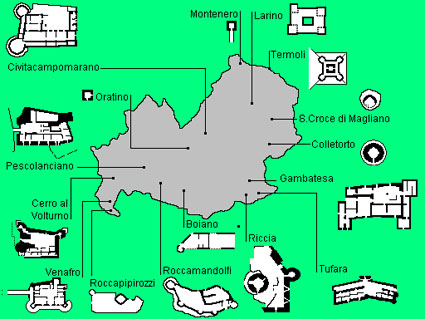![]() The historical development
of fortification architecture
The historical development
of fortification architecture
Molise
may be considered a “land of passage”, a region that, in the
course of history, has been repeatedly involved in historical
events that have deeply affected it; a region that, partly because
of this, has always shown a marked vocation to be a “land of
castles”. Towers, enclosing walls and castles are always
associated with the territory in a number of ways : they control
and subject it, but at the same time they depend upon it.
Fortifications
represent one of the most frequent classes of architectural “finds”.
Their specificity lies in the fact that they have very high levels
of survival and thresholds of vulnerability, since they were
designed, built and constantly adapted to new situations precisely
for the purpose of resisting as long as possible. The bad
condition of some fortifications is not so much due to wars or
natural cataclysms, but rather to the fact that castles, once they
became useless from a purely military point of view, were often
quarried for materials used for new constructions and were
subsequently abandoned. From this point of view, Molise has the
singularity, often connected with its poverty, of witnessing the
constant re-utilisation of ancient buildings, with adaptations
which were at times extreme but which were frequently dictated by
the simple rule of necessity.
The presence of fortifications
in Molise is a constant feature throughout its history: enclosures
from the Samnite age ; fortified camps and walled cities from Roman
times; Longobard, Norman, Swabian and Angevin settlements,
installations and defensive works; fortified buildings dating back
to the Aragonese period. Molisian toponymy is full of place names
that refer to fortifications : la Torretta (the Small Tower), la
Guardiana (the Guardian), la Rocca (the Fortress), Tre Torrette (Three
Towers), la Torre (the Tower), etc... The castle, under these
conditions, takes on the role of a primary element for the
interpretation of the territory’s history.
